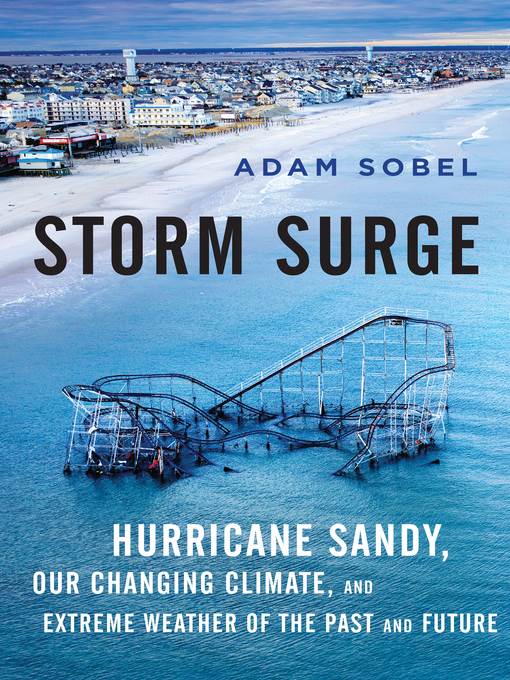
Storm Surge
Hurricane Sandy, Our Changing Climate, and Extreme Weather of the Past and Future
کتاب های مرتبط
- اطلاعات
- نقد و بررسی
- دیدگاه کاربران
نقد و بررسی

October 13, 2014
Hurricane Sandy hit metropolitan New York hard in October 2012, knocking out power while ruining homes and businesses; it turned parts of Manhattan into swampland, flooded subway stations and transit tunnels, and devastated much of the Jersey shore. Though the damage it caused is irrefutable, the cause of the hurricane itself, says Columbia University atmospheric scientist Sobel, is up for debate. In this comprehensive volume, he looks at the science behind Sandy (and similar weather systems), examining the circumstances leading to itâ"the left turn it took" in the ocean in "a radical departure from all known meteorological history"âand factors that made it a superstorm. How did it complete "its transition from a tropical cyclone to a mammoth hybrid"? Sobel diligently re-creates a timeline, from the early warnings issued by the National Hurricane Center to government evacuation orders to the impact Sandy had once it made landfall. Along the way, he provides substantial background information on what, exactly, a hurricane is and how the Fujiwhara effectânamed for Japanese meteorologist Sakuhei Fujiwharaâapplies to dueling vortices. Topics like these make for interesting, if technical, reading, and Sobel manages to strike an effective balance.

October 1, 2014
Sobel (Environmental Sciences and Applied Physics and Mathematics/Columbia Univ.) grapples with the "complex questions involving science, engineering, politics, and human psychology" that arose in Hurricane Sandy's wake. The author, who spends much of his time at Columbia studying climate and extreme weather, looks to Hurricane Sandy as a good example to help explain the scientific modeling that predicted the hurricane's birth and path. Sandy was certainly an unusual event-in the past 150 years of keeping weather records, no hurricane has made the fast left turn she did-and Sobel wants readers to comprehend Sandy as both a specific phenomenon and within the global picture, to understand the nature of Sandy and the atmospheric forces at play, which means a considerable dip into physics, meteorology and climatology. That dip turns out to be gratifying, as the author provides a readable introduction to patterns in the global atmosphere, their changes and the influence they have on weather events. Once through this basic course, which includes forays into hurricane science, winter weather and the history of forecasting, readers will walk away with a handle on the dynamics of weather systems. Sobel uses music to help explain coherent patterns applicable to weather, and he delivers approachable discussions of the Fujiwhara effect ("Two giant entities in the atmosphere, dangerous and powerful but elemental...normally solitary, each doing its own thing, engage with each other") and other phenomena. For tonal color, Sobel ends his examination of Sandy with a look at the Occupy movement and its role in recovery from the storm. He then shifts to a satisfying survey of updates and clarifications on the climate change front (including the vexing water-vapor issue) and the evolution of risk-management barriers and preventative measures. An engaged and engaging examination of "what current science allows us to say (or does not) about Sandy's relation to human-induced climate change."
COPYRIGHT(2014) Kirkus Reviews, ALL RIGHTS RESERVED.

November 1, 2014
Sobel is uniquely suited to write about Hurricane Sandy, the 2012 storm that hit the New York area. Beyond the author's credentials as accomplished atmospheric scientist and Columbia University professor, he is also a native New Yorker. This book fascinates in part because of its temporal shifts: Sobel's narrative of the developing cyclone is shown in "real time," which includes actual uppercase forecasts from the National Hurricane Center. The author looks back to explain some of the key discoveries in meteorology and forward to surmise what a warming planet could mean for future weather events. The work's simple two-part organization aids comprehension: the first alternates hurricane reports with chapters on the physics of cyclones and their prediction. The teacher in Sobel appreciates the utility of breaking hard science into smaller, more digestible bits, while the writer in him recognizes the drama of catastrophe. The second part deals with the thorny issue of hurricanes and climate change and reports on some amazing engineering solutions to the problem of rising seas. VERDICT Sobel presents rigorous science and acronyms and terminology abound (e.g., MJO, NAO, FFT, SST, Baroclinic effect, Coriolis force, Fujiwhara effect). But even without a glossary, the author makes complex subject matter intelligible and intriguing.--Robert Eagan, Windsor P.L., Ont.
Copyright 2014 Library Journal, LLC Used with permission.

October 1, 2014
Two years after Hurricane Sandy struck the Eastern Seaboard, flooding lower Manhattan and parts of Atlantic City, coastal residents are still cleaning up and rebuilding homes, while meteorologists and city planners contemplate what lessons can be learned from the natural disaster. As both an environmental sciences professor at Columbia University and someone who witnessed the devastation firsthand from his New York City apartment, Sobel has the perfect vantage point to mull over those lessons and offer insights about preparing for the next megastorm, as Sandy has been called. In 28 absorbing and instructive chapters, Sobel recounts the full history of the hurricane, including its warning signs and an explanation of the weather anomalies that forced Sandy to make a sudden left turn into the New Jersey coastline. He also explores the debate about how much climate change played a role in Sandy's devastating impact and examines how we can better respond to other extreme weather events. Must reading for earth-science and weather buffs and anyone living along the vulnerable passageways of potential future hurricanes.(Reprinted with permission of Booklist, copyright 2014, American Library Association.)

























دیدگاه کاربران